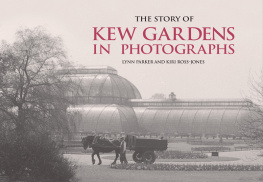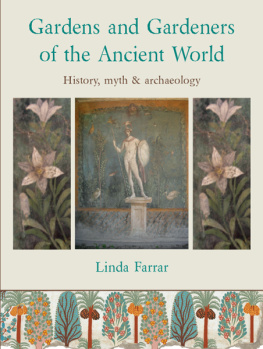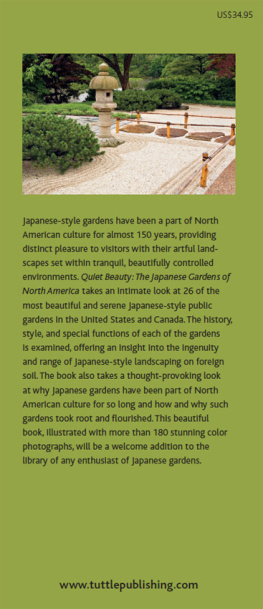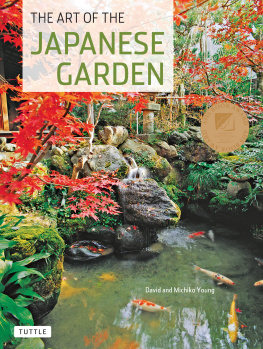
Published in 2015 by Abrams Image, an imprint of ABRAMS
Text copyright 2015 The Garden Conservancy
Photographs copyright 2015 Marion Brenner
courtesy of Klara Sauer
courtesy of Caroline Burgess
All rights reserved. No portion of this book may be reproduced, stored in a retrieval system, or transmitted in any form or by any means, mechanical, electronic, photocopying, recording, or otherwise, without written permission from the publisher.
Library of Congress Control Number: 2014959140
ISBN: 978-1-61769-165-2
eISBN: 978-1-68335-030-9
Editor: Leslie Stoker
Designer: William van Roden
Production Manager: Denise LaCongo
Abrams Image books are available at special discounts when purchased in quantity for premiums and promotions as well as fundraising or educational use.
Special editions can also be created to specification.
For details, contact specialsales@abramsbooks.com or the address below.

ABRAMS The Art of Books
115 West 18th Street
New York, NY 10011
www.abramsbooks.com
Funding provided in part by our foundation partners:
Stockman Family Foundation



To Anne Cabot
Contents
Foreword
People garden to make a difference in their own and other peoples lives. Gardening, which often begins as a pastime, can become an obsession. And like all forms of art, gardening can transform the mundane and ordinary into something transcendent and inspiring, something that refreshes the dry places in our spirit. Some people can even elevate gardening to their principal raison dtre.
Frank Cabot was passionate about many things in his life, from oysters to close-harmony singing to alpine rock plants. Luckily for him, he was able to share his enthusiasms with his friends, and ultimately with gardeners everywhere, thanks to the organization he and my mother dreamt up: the Garden Conservancy. He loved traveling the world looking for rare and interesting plants, and at the same time sought out gardens made by people who understood and loved the plants they used, and who also had the gifts and skills to integrate the disciplines necessary to make their gardens into works of art.
The Garden Conservancy was the expression of the side of my father that loved the community of souls united by the gift of being able to know, grow, and use plants to create a sum greater than the parts they started with. This value-added aspect of gardening that transforms mere musings into inspired flights of fantasy has inspired a lot of very generous people over the last twenty-five years to open their gardens to visitors, to share their expertise, and to contribute lavishly in support of what my father considered a neglected art form, especially in the United States. The visionary expressions of true garden artists are realized in ephemeral moments that often escape even their creators notice. Too many variables are at play to actually enable the scheduling of the performance of a garden. A visionary gardener must collaborate with sun and wind and water and soil and all the permutations of seasonal variability before announcing to the awaiting audience that the moment of performance has arrived.
I remember very clearly a moment when my father came rushing into the house as the family was gathering for the evening meal and exhorted us to visit the perennial alle at the Quatre Vents garden because It will never be better.
In truth, the play of light and the warmth of an evening in late July made sublime the extraordinary layering of delphinium, thalictrum, filipendula, iris, ligularia, cimicifuga, and digitalis (among many other exuberant plants) that filled the beds. We returned to the house refreshed, exhilarated, and totally unaware of the extraordinary amount of work and thought that had gone into the creation of that perfect moment in the garden. Nevertheless, the moment was unforgettable and would have gone unnoticed without my fathers exhortation to seize the moment. Blessings on him for that.
The Garden Conservancy was created to preserve and share such moments with an ever-growing public. This book is an eloquent vindication of its ambitious goals. May gardeners revel in it, and may those of us yet to become gardeners find inspiration in its pages and learn to appreciate more fully what Francis Bacon called the purest of pleasures. Colin Cabot

Frank Cabots wife, Anne, made a lighthearted suggestion that encouraged him to found the Garden Conservancy in 1989, an organization that would become a champion for outstanding gardens across America.

Frank and Anne show their obvious delight at standing in a field of Texas bluebonnets during an early Society of Fellows tour.
Introduction
Frank Cabot, the founder of the Garden Conservancy, liked to describe himself as a horticultural enthusiast whose interests were both passionate and varied. He was an active member of a number of horticultural organizations. He also designed and created two extraordinary gardens of his own: Stonecrop, in Cold Spring, New York; and Les Quatre Vents, in La Malbaie, Quebec. By 1988, when Frank and his wife, Anne, took a trip to California, the idea of forming a national organization to preserve exceptional American gardens had been on his mind for a long time. At the suggestion of English garden writer Penelope Hobhouse, he and Anne visited Ruth Bancrofts succulents garden near San Francisco. Here is how Frank tells the story: It was a garden filled with cactus, which is not my thing at all. [But] we were so overwhelmed by the experience that, much to my great surprise, I remember actually shivering at the beauty of it.
During their visit, Ruth expressed her fear that her garden would disappear after she was no longer able to take care of it. As we drove away, I said to my wife, We have to find some way to help this woman. And she said, rather facetiously, Why dont you start a garden conservancy? And, of course, that rang all sorts of bells.
The Garden Conservancy began the following year in a small office in Cold Spring, and Frank Cabots vision for a national organization to preserve exceptional American gardens for the public was realized. Along with Antonia Adezio, the new Garden Conservancys Executive Director, Frank sought the advice of his many friends in the gardening world to form an Advisory Committee of other leading horticultural enthusiasts and professionals, as well as a Screening Committee led by Marco Polo Stufano, the creator of the Wave Hill public gardens in New York City. These committees would help identify outstanding private gardens that might be preserved.
As Frank described the origins of the Garden Conservancy: The original conception was to try to save the private works of art created by people like Ruth Bancroft. We would not only be an advocate for the preservation of that kind of garden but a catalyst that would actually make it happen. We would set up an organization that would facilitate the transition from private to public ownership for posterity.
Next page
















